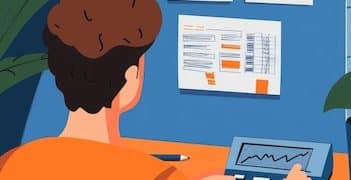Bankruptcy Options: A Comprehensive Guide to Debt Relief Under Chapter 7 and Chapter 13

Navigating debt relief is complex, and understanding your options under Chapter 7 and Chapter 13 bankruptcy is crucial for financial recovery, offering distinct pathways tailored to different financial situations and goals.
Facing overwhelming debt can be a daunting experience, leaving many individuals feeling trapped with no clear path forward. This comprehensive guide delves into Bankruptcy Options: A Comprehensive Guide to Debt Relief Under Chapter 7 and Chapter 13, shedding light on how these legal frameworks can offer a fresh financial start for those struggling to manage their obligations. Understanding the nuances of each chapter is paramount to making an informed decision about your financial future.
Understanding the Landscape of Bankruptcy
Bankruptcy, often viewed as a last resort, is a legal process designed to help individuals and businesses eliminate or repay some or all of their debts under the protection of the federal bankruptcy court. It provides a structured path for debt relief, allowing debtors to discharge certain debts and get a fresh financial start. While the thought of bankruptcy can be intimidating, it is a tool embedded in the legal system to aid those in severe financial distress, preventing an endless cycle of debt.
The U.S. Bankruptcy Code outlines different types of bankruptcy, but for individuals, Chapter 7 and Chapter 13 are the most common and relevant options. Each chapter serves distinct purposes and is designed for different financial circumstances. Deciding between them requires a thorough understanding of their requirements, benefits, and potential drawbacks, as the choice profoundly impacts one’s assets, credit, and future financial stability.
The Purpose of Bankruptcy in Debt Relief
Bankruptcy serves as a formidable legal mechanism when conventional debt management strategies prove ineffective. It offers a legal reprieve, halting collection efforts and wage garnishments, providing debtors the necessary breathing room to reorganize their finances without constant pressure from creditors. The intent is not to encourage irresponsible spending, but to offer a lifeline during financially challenging times, ensuring individuals can eventually contribute positively to the economy once more.
- Automatic Stay: A key protection, immediately stopping most collection actions upon filing.
- Debt Discharge: The primary goal, eliminating legal obligation to pay certain debts.
- Financial Fresh Start: Provides an opportunity to rebuild credit and manage future finances better.
Beyond the immediate relief, bankruptcy also has long-term implications, both positive and negative. While it can severely impact credit scores in the short term, it also clears the slate, allowing for a structured approach to financial recovery. Without the burden of old debts, individuals can more effectively manage current expenses and save for the future. The process emphasizes financial education and responsible planning to prevent future insolvency.
Chapter 7 Bankruptcy: The Liquidation Option
Chapter 7 bankruptcy, often referred to as “liquidation bankruptcy,” is typically chosen by individuals with limited income and significant unsecured debts, such as credit card debt, medical bills, and personal loans. The primary goal of Chapter 7 is to eliminate these debts by discharging them, without requiring a repayment plan. In exchange, a bankruptcy trustee may liquidate non-exempt assets to pay off creditors, though in many cases, debtors possess primarily exempt assets.
For individuals to qualify for Chapter 7, they must pass a “means test,” which compares their income to the median income in their state. If their income is below the median, they generally qualify. If their income is above the median, further calculations are made to determine if they have enough disposable income to repay a portion of their debts. This test ensures that Chapter 7 is primarily available to those truly unable to afford a repayment plan.

Eligibility and the Means Test
The means test is a critical component of Chapter 7 eligibility. It’s designed to prevent higher-income individuals from filing for Chapter 7 when they could realistically afford to repay some of their debts under Chapter 13. Understanding how this test works is fundamental to determining if Chapter 7 is a viable option.
- Income Threshold: Your current monthly income is compared against the state’s median income for a household of your size.
- Disposable Income Calculation: If your income exceeds the median, further calculations deduct allowed expenses to determine if sufficient disposable income remains for debt repayment.
- Presumption of Abuse: If disposable income is above a certain threshold, a presumption of abuse arises, making Chapter 7 difficult, though not impossible, to achieve.
Even if you pass the means test, other factors can influence your eligibility, such as having filed for bankruptcy previously. A qualified bankruptcy attorney can accurately assess your financial situation, conduct the means test, and advise on the most appropriate course of action, ensuring all legal requirements are met for a successful filing.
What Happens to Your Assets in Chapter 7?
A common misconception about Chapter 7 is that all assets will be seized and sold. In reality, federal and state laws provide “exemptions” that protect certain types of property from liquidation. These exemptions vary by state, but commonly include primary residences (up to a certain value), essential household goods, vehicles, retirement accounts, and tools of trade.
Upon filing, all your assets become part of the “bankruptcy estate,” managed by a court-appointed trustee. The trustee’s role is to identify non-exempt assets, sell them, and distribute the proceeds to creditors. However, in a significant number of Chapter 7 cases, all of the debtor’s assets are found to be exempt, resulting in a “no-asset” case where creditors receive no payment from asset liquidation.
Chapter 13 Bankruptcy: The Reorganization Option
Chapter 13 bankruptcy, known as “reorganization bankruptcy,” is suitable for individuals with a regular income who can afford to repay some or all of their debts over time. Instead of liquidating assets, Chapter 13 involves proposing a repayment plan to the court, typically lasting three to five years. This plan outlines how the debtor will pay back creditors, often at a reduced amount, from their disposable income.
Chapter 13 is particularly beneficial for debtors who want to keep their property, such as a home or car, that might otherwise be at risk in a Chapter 7 filing. It also allows individuals to catch up on missed mortgage or car payments, prevent foreclosure, or address non-dischargeable debts like certain taxes or child support arrears through a structured plan.
The Chapter 13 Repayment Plan
The core of Chapter 13 is the meticulously crafted repayment plan. This plan details how you will repay priority debts (such as child support, certain taxes) in full, secured debts (like mortgages and car loans) according to their original terms or modified terms, and unsecured debts (like credit cards) often at a fraction of what is owed.
- Duration: Plans typically last between three and five years. A three-year plan is for debtors with income below their state’s median; a five-year plan for those above.
- Disposable Income: The plan is funded by your disposable income, which is your income minus necessary living expenses.
- Court Approval: The bankruptcy court must approve the plan, ensuring it’s feasible and fair to both debtors and creditors.
Once the plan is confirmed, you make regular payments to a bankruptcy trustee, who then distributes the funds to your creditors. Upon successful completion of the plan, any remaining dischargeable unsecured debts are discharged. This process allows debtors to save their assets while diligently working towards financial solvency under judicial oversight.
Benefits and Limitations of Chapter 13
Chapter 13 offers several distinct advantages, especially for those seeking to protect assets and manage complex financial situations without immediate liquidation. It provides a structured environment for financial rehabilitation, fostering responsible repayment over time. Debtors emerge from Chapter 13 having fulfilled their obligations under court-approved terms, often with a stronger grasp of their financial future.
- Asset Protection: Allows debtors to keep all their property, unlike Chapter 7 where non-exempt assets may be sold.
- Foreclosure Prevention: Can stop foreclosure proceedings and allow debtors to catch up on missed mortgage payments.
- Debt Restructuring: Ability to modify certain loan terms, like reducing interest rates on car loans, or stripping off second mortgages in some cases.
However, Chapter 13 also comes with limitations. The financial obligations are substantial, requiring consistent payments over an extended period. Not all debts are dischargeable, and the process can be more complex and lengthy than Chapter 7. Eligibility also depends on meeting specific debt limits for both secured and unsecured debts. These factors underscore the need for careful consideration and professional guidance before proceeding.
Key Differences Between Chapter 7 and Chapter 13
The choice between Chapter 7 and Chapter 13 is a pivotal one, with each option offering a distinct approach to debt resolution. The primary differentiator lies in the treatment of assets and the mechanism for debt repayment. Chapter 7 focuses on the discharge of debts, potentially involving asset liquidation, while Chapter 13 prioritizes debt repayment through a structured plan, allowing debtors to retain their property.
Another significant distinction is the eligibility criteria. Chapter 7 is generally for those with lower incomes who do not have the disposable income to repay debts, whereas Chapter 13 is for individuals with regular income who can commit to a repayment plan. The impact on credit history, while negative for both, also varies in the long term, making a clear understanding of these differences essential for informed decision-making.

Eligibility and Debt Limits
Eligibility for each chapter is not merely a matter of preference but is determined by specific legal criteria. The means test for Chapter 7 is a strict gatekeeper, ensuring that debt discharge without repayment is reserved for those genuinely unable to pay. Conversely, Chapter 13 has debt limits that govern who can file, making it unsuitable for individuals with extremely high debt loads.
- Income: Chapter 7 is for lower-income individuals or those with significant expenses relative to income. Chapter 13 is for individuals with regular income.
- Debt Limits: Chapter 13 has statutory limits on both secured and unsecured debt levels that a debtor can have to qualify. Chapter 7 has no such debt limits.
- Prior Filings: Both chapters have restrictions on how frequently one can file for bankruptcy, which influences eligibility for a discharge in a subsequent filing.
These distinctions underscore the importance of thoroughly evaluating one’s financial standing and objectives before proceeding. A detailed assessment by a bankruptcy attorney can help navigate these complex rules and ensure compliance with all legal requirements, mitigating the risk of dismissal or adverse outcomes in court. The advice of a legal professional can make a significant difference in the success of a bankruptcy filing.
Impact on Assets and Property
The treatment of assets is perhaps the most significant practical difference between Chapter 7 and Chapter 13. In Chapter 7, non-exempt assets are subject to liquidation by the trustee to pay creditors. While a considerable number of assets are typically exempt, a debtor with substantial non-exempt equity could lose valuable property.
Chapter 13, on the other hand, offers a mechanism to protect all assets. Debtors can retain their property, including homes and cars, as long as they adhere to the terms of their court-approved repayment plan. This makes Chapter 13 a compelling option for individuals who wish to preserve their large assets, such as those with significant home equity or multiple vehicles, provided they can afford the payments.
The Bankruptcy Process: What to Expect
Regardless of whether you choose Chapter 7 or Chapter 13, the bankruptcy process involves several key steps. It begins with credit counseling, followed by the filing of a petition and supporting schedules with the bankruptcy court. These documents provide a detailed snapshot of your financial situation, including assets, liabilities, income, and expenses. The accuracy and completeness of these documents are crucial.
Once filed, an “automatic stay” immediately goes into effect, halting most collection activities. This provides immediate relief from creditor calls, lawsuits, and wage garnishments. Subsequently, a meeting of creditors (also known as a 341 meeting) is scheduled, where the debtor appears before the bankruptcy trustee and creditors to answer questions under oath about their financial affairs. This meeting is typically brief and uneventful, especially if all documentation is in order.
Preparation and Filing
The journey through bankruptcy begins long before the actual filing, with intensive preparation that demands meticulous attention to detail. Gathering all relevant financial documents is paramount, including bank statements, tax returns, pay stubs, and comprehensive lists of creditors and their respective debts. This documentation forms the backbone of your bankruptcy petition.
- Credit Counseling: Mandatory before filing, debtors must complete a credit counseling course within 180 days of filing.
- Document Gathering: Collect all financial records for the past several years, including asset valuations.
- Petition and Schedules: Prepare comprehensive legal documents detailing all assets, debts, income, and expenses, ensuring accuracy.
Working with an experienced bankruptcy attorney can streamline this process significantly. They not only ensure that all paperwork is correctly prepared and filed but also provide crucial guidance on understanding local and federal bankruptcy laws. Their expertise helps in identifying potential legal pitfalls and maximizes the chances of a smooth and successful bankruptcy process, leading to the desired debt relief.
Meeting of Creditors and Discharge
The meeting of creditors, or 341 meeting, is a standard and often straightforward part of the bankruptcy process. Although creditors are invited, they rarely attend in Chapter 7 cases, unless there are complex issues or suspicions of fraud. The primary attendees are typically the debtor, their attorney (if represented), and the bankruptcy trustee.
The trustee’s role is to verify the information in your petition, clarify any discrepancies, and ensure that you understand the implications of filing for bankruptcy. Following this meeting, and after all procedural requirements are met, the court will typically issue a discharge order. This order legally releases you from the obligation to pay specified debts, marking the successful completion of your bankruptcy journey and signaling the beginning of your financial fresh start.
Life After Bankruptcy: Rebuilding Your Financial Future
Successfully navigating Chapter 7 or Chapter 13 bankruptcy is not the end, but rather the beginning of a deliberate journey toward financial recovery. While bankruptcy can negatively impact your credit score for several years, it also provides a unique opportunity to rebuild your financial life on a solid foundation, free from the burdens of past debts. The key to a strong recovery lies in adopting responsible financial habits and strategically rebuilding credit.
Immediately after discharge, it is crucial to focus on practical steps such as creating and sticking to a budget, saving an emergency fund, and living within your means. The financial discipline acquired during and after bankruptcy is invaluable. Actively engaging in credit rebuilding efforts, such as securing a secured credit card or a small loan, can gradually improve your credit profile over time, opening doors to future financial opportunities.
Strategies for Credit Rebuilding
Rebuilding credit after bankruptcy requires patience and a strategic approach. It’s a marathon, not a sprint, but consistent effort can lead to significant improvements in your credit score within a few years. Starting with basic steps and gradually progressing to more complex financial products is the most effective path.
- Secured Credit Card: This is often the first step, requiring a cash deposit that becomes your credit limit, helping to establish a positive payment history.
- Small Installment Loan: A credit-builder loan, often from credit unions, can help diversify your credit mix.
- Monitor Your Credit: Regularly check your credit reports for accuracy and to track your progress. Dispute any errors promptly.
It is important to avoid falling back into old habits that led to debt. Focus on using credit sparingly and paying all bills on time and in full. Over time, as responsible financial behaviors become ingrained, creditors will view you as a lower risk, and your credit opportunities will expand. This disciplined approach ensures that bankruptcy serves as a true reset, empowering you with better financial health for the future.
Long-Term Financial Planning
Beyond immediate credit rebuilding, successful navigation through and after bankruptcy demands a robust long-term financial plan. This involves not just managing current expenses, but also setting realistic goals for savings, investments, and future major purchases. Establishing a sustainable financial framework is essential to prevent future debt accumulation.
The experience of bankruptcy can be a powerful teacher, highlighting the importance of financial literacy. Consider enrolling in financial literacy courses, consulting with financial advisors, and continuously educating yourself on personal finance best practices. Building a solid emergency fund should be a top priority, as it provides a buffer against unexpected expenses and reduces reliance on credit in crises.
Developing a comprehensive budget that includes savings and debt repayment (if any small amounts remain) is crucial. Explore investment options that align with your risk tolerance and financial goals, always prioritizing long-term growth and stability over quick returns. By integrating these practices, you can leverage the fresh start provided by bankruptcy into a truly secure and prosperous financial future.
Seeking Professional Legal Advice
The complexities of bankruptcy law, combined with the significant financial and personal implications, make seeking professional legal advice an indispensable step. A qualified bankruptcy attorney can provide tailored guidance, assess your specific financial situation, and help you determine whether Chapter 7 or Chapter 13 is the most appropriate option for your needs.
An attorney can assist with every stage of the process, from preparing and filing the voluminous paperwork to representing you in court and at the meeting of creditors. They can explain the intricacies of exemptions, the means test, and repayment plans, ensuring you understand your rights and obligations. Attempting to navigate bankruptcy without legal counsel can lead to costly errors, missed opportunities, or even the dismissal of your case.
Investing in legal expertise is an investment in your financial future. It ensures that the process is handled efficiently and correctly, maximizing your chances of a successful discharge and a fresh start. Do not hesitate to consult with an attorney specializing in bankruptcy law to explore all available options and make an informed decision that will best serve your long-term financial well-being.
| Key Point | Brief Description |
|---|---|
| 🚀 Chapter 7 Eligibility | Primarily for lower-income individuals based on a “means test,” leading to debt discharge. |
| ⏳ Chapter 13 Repayment | For regular-income earners, involves a 3-5 year court-approved debt repayment plan. |
| 🏡 Asset Protection | Chapter 13 allows debt repayment while keeping all assets; Chapter 7 may involve liquidation of non-exempt assets. |
| 📈 Credit Rebuilding | Both chapters require deliberate strategies post-discharge to restore and improve credit scores. |
Frequently Asked Questions About Bankruptcy
The automatic stay is a powerful injunction that immediately goes into effect upon filing for bankruptcy. It stops most collection actions by creditors, including lawsuits, wage garnishments, repossessions, and foreclosure processes. This provides debtors with immediate relief and a legal breathing room to reorganize their finances without harassment.
Not necessarily. While Chapter 7 is a liquidation process, federal and state laws provide “exemptions” that protect certain types of property from being sold. Common exempt items include a portion of home equity, essential household goods, retirement accounts, and a vehicle. Many Chapter 7 cases are “no-asset” cases, meaning all property is exempt.
Chapter 13 bankruptcy stays on your credit report for seven years from the filing date, though its impact diminishes over time. While it initially lowers your score, successfully completing a repayment plan and demonstrating responsible financial habits post-bankruptcy can lead to significant credit rebuilding and an improved financial standing over the long term.
No, not all debts are dischargeable. Common non-dischargeable debts include most student loans (except in rare hardship cases), child support and alimony, certain taxes, debts for personal injury caused by driving while intoxicated, and criminal fines. Secured debts, like mortgages and car loans, typically require continued payment unless the property is surrendered.
While it is legally possible to file for bankruptcy without an attorney (pro se), it is highly advisable to seek legal counsel. Bankruptcy law is complex, and an experienced attorney can ensure all documents are properly filed, help you understand exemptions, navigate the means test, and represent your interests effectively, maximizing your chances of a successful outcome.
Conclusion
Choosing between Chapter 7 and Chapter 13 bankruptcy is a significant decision with lasting repercussions on your financial life. Each option offers unique advantages and challenges, tailored to different financial circumstances. Chapter 7 provides a swift discharge of unsecured debts for those with limited income, potentially involving asset liquidation, while Chapter 13 offers a structured repayment plan over several years, allowing debtors to protect their assets. Understanding the nuances of eligibility, asset treatment, and the overall process is paramount. Ultimately, both chapters serve as powerful tools for debt relief, offering a pathway toward a fresh financial start, provided they are approached with careful consideration and, ideally, with the guidance of experienced legal counsel. Your journey to financial recovery begins with an informed choice, leading to a more secure future.





